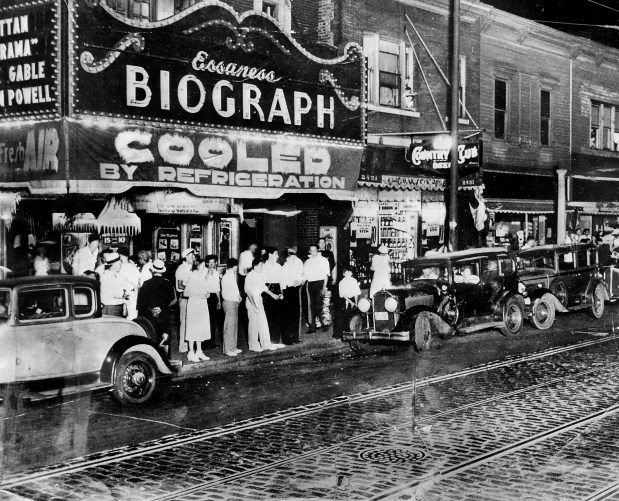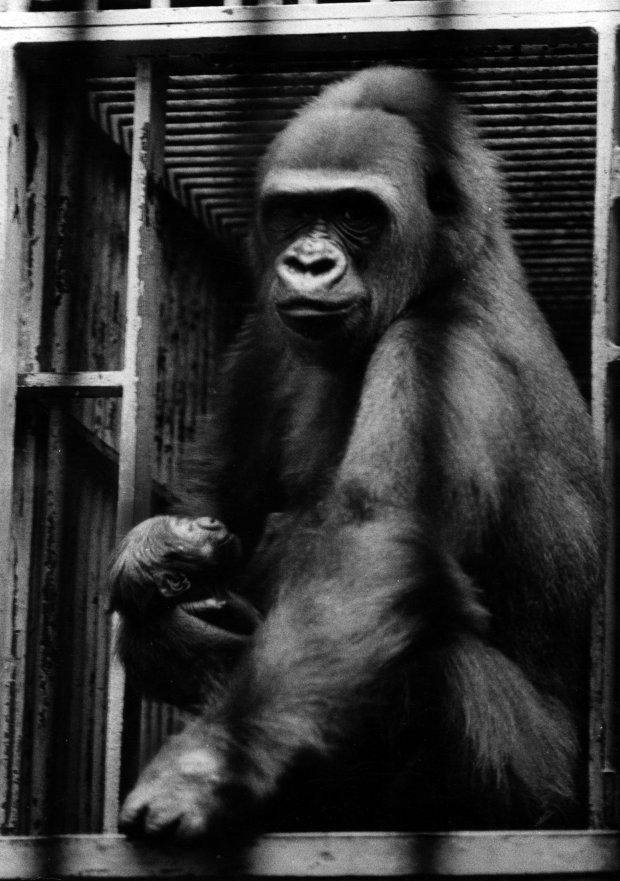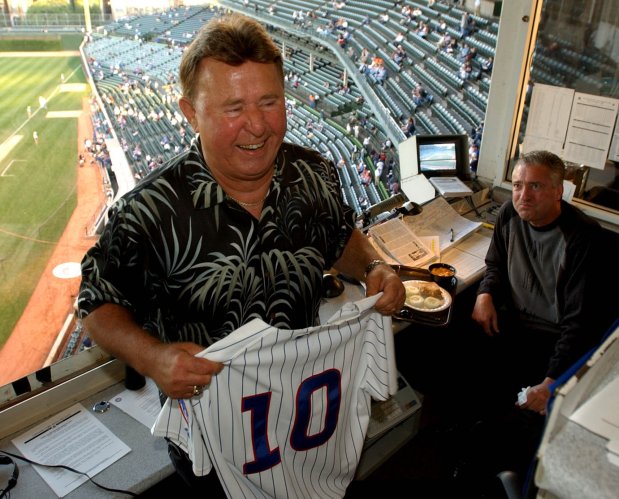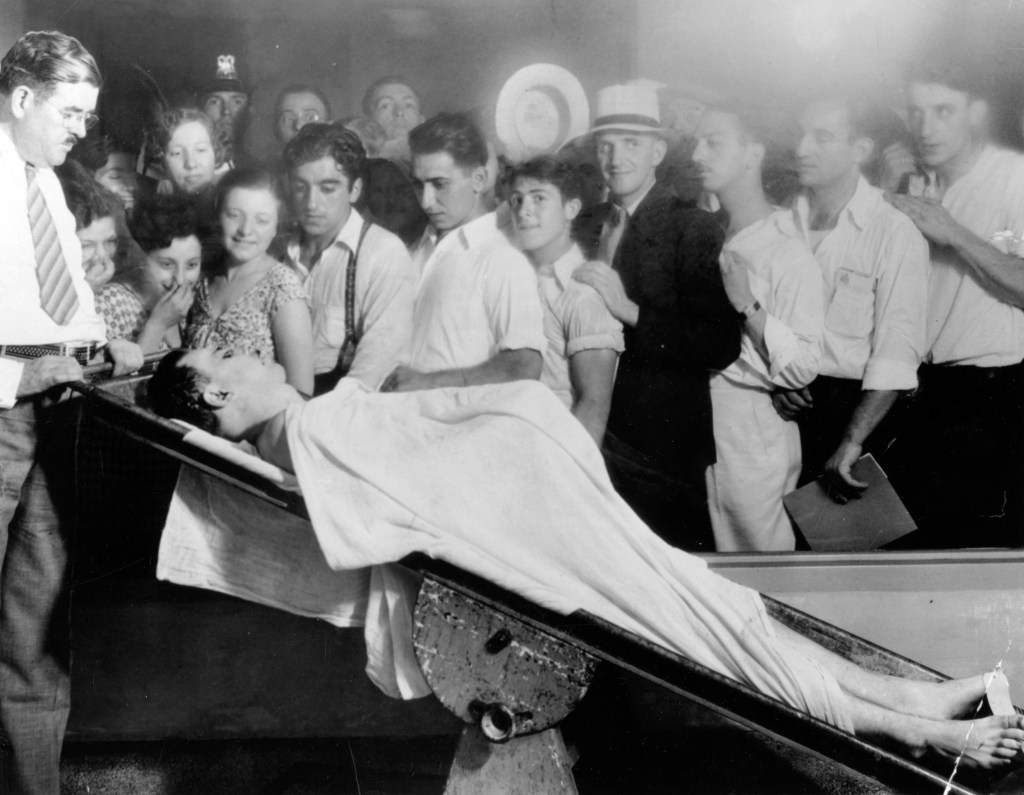Here’s a look back at what happened in the Chicago area on July 22, according to the Tribune’s archives.
Is an important event missing from this date? Email us.
Weather records (from the National Weather Service, Chicago)
- High temperature: 101 degrees (1991)
- Low temperature: 49 degrees (1947)
- Precipitation: 2.26 inches (1982)
- Snowfall: Trace (2001)
 The Biograph Theater on Lincoln Avenue where John Dillinger was slain by FBI bullets in 1934. (Chicago Tribune historical photo)
The Biograph Theater on Lincoln Avenue where John Dillinger was slain by FBI bullets in 1934. (Chicago Tribune historical photo)
1934: Chicago was in the grip of a weeklong heat wave, and the mercury that day reached 101. Twenty-three people died of the heat, but the death that drew the most attention was that of John Dillinger — a 31-year-old Indiana man who, on his birthday a month earlier, had been declared Public Enemy No. 1 by the FBI.
In the heat of that July, movie houses advertised that they were “air-cooled.” Perhaps that’s what made Dillinger decide to take a prostitute named Polly Hamilton and Hamilton’s landlady, Anna Sage, to the Biograph Theater (now known as Victory Gardens Theater) at 2433 N. Lincoln Ave., to see “Manhattan Melodrama,” a gangster movie starring Clark Gable. Sage, a Romanian immigrant originally named Ana Cumpanas, operated a house of ill repute on the North Side.
Vintage Chicago Tribune: John Dillinger’s final days — and the ‘Lady in red’ who helped trap him
Outside the theater, about 16 federal agents and East Chicago police officers took up positions.
When the picture was over around 10:30 p.m., the trio left the theater and turned south on Lincoln Avenue in the direction of Sage’s apartment on Halsted Street. The artificial lights of the marquee made her orange skirt appear deep red — earning her the nickname “Lady in Red.”
As the three walked south on Lincoln, Dillinger realized he was walking into a trap and pulled an automatic pistol from his pants pocket and bolted for the alley. Shots were fired. One bullet hit him in the back of the neck and exited through his right eye. That shot killed him. It apparently was fired by East Chicago police Sgt. Martin Zarkovich’s .38-caliber revolver. The weapon was bought by a San Francisco man at a 1998 auction for more than $25,000.
 Betty Nelson and Rosella Nelson view the body of John Dillinger, 32, while in bathing suits at the Cook County Morgue, located at Polk and Wood streets in Chicago. In the days after Dillinger was killed on July 22, 1934, massive crowds lined up outside the morgue to get a glimpse of the notorious public enemy. (Chicago Herald & Examiner historical photo)
Betty Nelson and Rosella Nelson view the body of John Dillinger, 32, while in bathing suits at the Cook County Morgue, located at Polk and Wood streets in Chicago. In the days after Dillinger was killed on July 22, 1934, massive crowds lined up outside the morgue to get a glimpse of the notorious public enemy. (Chicago Herald & Examiner historical photo)
Thus came to an end Dillinger’s long and infamous career in crime, including 11 months at the top of the country’s Most Wanted list. Souvenir seekers dipped handkerchiefs in Dillinger’s blood.
Sage got a $5,000 reward for her role, but not the deal she wanted. She was deported to Romania in 1936 and died there 11 years later.
 The first gorilla born in Lincoln Park Zoo’s 102-year history, Kumba, is held by her 9-year-old mother, Mumbi, on July 23, 1970. The infant gorilla weighed about three and a half pounds at birth. (Charles Osgood/Chicago Tribune)
The first gorilla born in Lincoln Park Zoo’s 102-year history, Kumba, is held by her 9-year-old mother, Mumbi, on July 23, 1970. The infant gorilla weighed about three and a half pounds at birth. (Charles Osgood/Chicago Tribune)
1970: A western lowland gorilla — named Kumba — was born for the first time in the 102-year history of Lincoln Park Zoo.
“(Mom) Mumbi had no help at all with the delivery. She was her own midwife,” assistant zoo director Saul Kitchener said.
 Filming in Chicago for “The Blues Brothers” movie starring John Belushi as Joliet Jake and Dan Aykroyd as Elwood Blues began on July 22, 1979. (Chicago Tribune)
Filming in Chicago for “The Blues Brothers” movie starring John Belushi as Joliet Jake and Dan Aykroyd as Elwood Blues began on July 22, 1979. (Chicago Tribune)
1979: Parts of Lake Shore Drive, the Eisenhower Expressway and seven bridges over the Chicago River were closed for filming of “The Blues Brothers.”
 Twenty-eight-year-old Marla Collins, ballgirl at Wrigley Field for the Chicago Cubs since 1982, was fired on July 22, 1986, after revealing photos of her were released in an edition of Playboy magazine. “After learning that she had been fired, Collins headed for a bar,” the Tribune reported. (Chicago Tribune)
Twenty-eight-year-old Marla Collins, ballgirl at Wrigley Field for the Chicago Cubs since 1982, was fired on July 22, 1986, after revealing photos of her were released in an edition of Playboy magazine. “After learning that she had been fired, Collins headed for a bar,” the Tribune reported. (Chicago Tribune)
1986: The Chicago Cubs fired ballgirl Marla Collins after she posed for a Playboy pictorial.
“Sportswriters pored over the photo evidence for hours Tuesday afternoon in the Wrigley Field pressbox, trying desperately to determine just how offensive the exposé was,” Tribune reporter Fred Mitchell wrote. “Meanwhile, the Cubs won a game. The score was 6-4. We think.”
2003: A 10-year-old, 124-pound rescued and rehabilitated green sea turtle — named Nickel due to the coin found lodged in her esophagus — was released into the Caribbean Reef exhibit at the Shedd Aquarium.
 Chicago Cubs great Ron Santo — in the Wrigley Field booth where he provides commentary for WGN radio — holds a jersey with his No. 10, on Sept. 15, 2003, in Chicago. (Nuccio DiNuzzo/Chicago Tribune)
Chicago Cubs great Ron Santo — in the Wrigley Field booth where he provides commentary for WGN radio — holds a jersey with his No. 10, on Sept. 15, 2003, in Chicago. (Nuccio DiNuzzo/Chicago Tribune)
2012: Cubs third baseman turned broadcaster Ron Santo was posthumously inducted into the National Baseball Hall of Fame.
Santo, who died in 2010, told the Tribune in 2003 that the team’s retirement of his uniform No. 10 was special.
“It will be my Hall of Fame,” he said.
Want more vintage Chicago?
Subscribe to the free Vintage Chicago Tribune newsletter, join our Chicagoland history Facebook group, stay current with Today in Chicago History and follow us on Instagram for more from Chicago’s past.
Have an idea for Vintage Chicago Tribune? Share it with Kori Rumore and Marianne Mather at krumore@chicagotribune.com and mmather@chicagotribune.com
